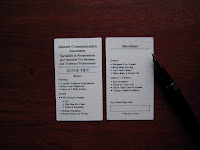
In the past, my enthusiasm to get in front of the customer often led me to think it was OK to spend little time planning a call and even less time writing down my plan. I was not alone. The percentage of sales and marketing pros that continue to wing it on calls is amazingly high. This is OK for transactional sales. But with the complex and expensive products, services and solutions, failure to plan will eventually cost you.
Old School: To maximize orders, sales and marketing must increase the number of customer visits we make and the number of proposals we generate. Less time spent preparing means more time for visits, more proposals, and with some God given capture rate percentage applied…more orders. Right? It doesn’t work that way. What does work is putting first things first and executing around priorities.
Success, for all professionals, is the natural outcome of consistently repeating some basic fundamentals. Preparation is key. To prepare properly, one must develop or adopt a selling system. Systems are not an unusual concept in professional disciplines. Who would ever suggest that pilots can fly an aircraft any way they wish. How about hospitals allowing surgeons to operate on patients with complete creative freedom? Of course not and neither should any sales professional. Taking the time to prepare a detailed sales call plan has to be part of ones daily work. “I’m too busy to plan” or “a call plan doesn’t make sense with this customer” is no excuse.
Success in complex sale is the result of tight and well planned team collaboration and execution. Don't wing it, plan it. Dig into preparation with intentness and you will attract more sales successes into your 2010 sales opportunities.
Good Selling!
steve











